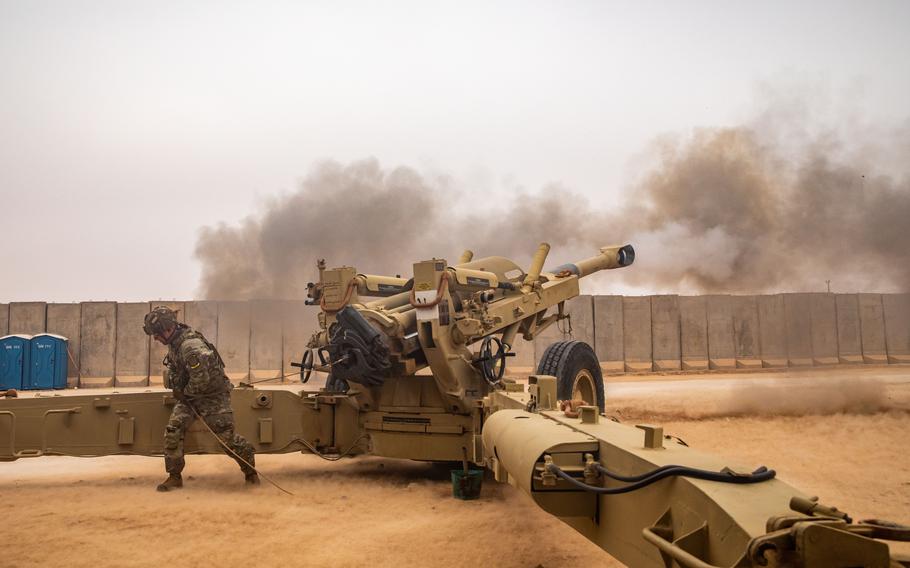
Brig. Gen. Michael Ecker fires an M198 155mm howitzer during an artillery live-fire exercise at al-Asad air base in Iraq on Dec. 20, 2023. (Quince Lanford/U.S. Army)
At least four American service members suffered traumatic brain injuries in an attack Saturday on an air base in central Iraq, the Pentagon’s top spokesman said Tuesday.
The latest count doubles the number of confirmed TBI diagnoses that Pentagon officials disclosed Monday, following the rocket and ballistic missile attack on al-Asad air base by Iran-backed militants. Air Force Maj. Gen. Pat Ryder, the Pentagon’s top spokesman, said Tuesday that the number of TBI cases could grow in the coming days as troops continue to be evaluated.
Ryder said the troops already diagnosed with TBIs from the Saturday attack had returned to duty since suffering their injuries.
At least one Iraqi service member was also injured in the attack, according to U.S. Central Command. Multiple rockets and ballistic missiles were fired at the base, which is about 100 miles west of Baghdad. Most of the munitions were intercepted, but some struck their targets, CENTCOM officials said.
Ryder said the attacks did not result in “significant damage to the facilities” at the base.
The attack was the latest in a string of strikes on American forces in Iraq and Syria by militia groups backed by Iran with the intent of driving U.S. troops out of the Middle East. The Pentagon said Monday that American forces in Iraq and Syria had been attacked at least 151 times since mid-October, following the Oct. 7 attacks by Hamas fighters on Israelis and the subsequent war on Gaza launched by Israel and backed by the United States.
Despite the increase in attacks on U.S. troops, Pentagon officials have said forces there and in neighboring Syria remain focused on their anti-Islamic State group mission, which began in 2014. About 2,500 U.S. troops are deployed in Iraq to help combat remnants of ISIS, while another about 900 are in Syria, where they work with Kurdish-led Syrian Democratic Forces.
Iraqi Prime Minister Mohammed Shia al-Sudani made headlines earlier this month calling for a drawdown of U.S. forces from his country, but Pentagon officials have said no plan had been enacted to move forces from Iraq or Syria.
Ryder said the United States was continuing “regular and ongoing” discussions with the Iraqi government about its military presence in the country, but he was “not aware of any official notifications to the department” to remove its troops.
The Saturday attack was not the first time that American forces faced a ballistic missile attack on al-Asad. In November, Iran-backed militants struck the base with a ballistic missile, resulting in several “non-serious” American injuries, Pentagon officials said at the time.
In January 2020, Iran’s Islamic Revolutionary Guard Corps fired more than one dozen ballistic missiles into al-Asad in retaliation for the killing one day earlier of the unit’s longtime commander, Maj. Gen. Qasem Soleimani, in a U.S. drone strike in Baghdad.
That attack on al-Asad left more than 100 American service members with TBIs, but no Americans were killed. About 80 U.S. troops received Purple Hearts for the injuries in that strike.